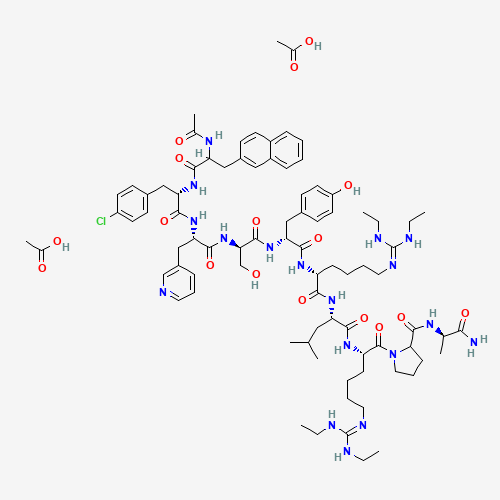| Pharmaceutical Information |
| Drug Name |
Antagon |
| Drug ID |
BADD_D00144 |
| Description |
Ganirelix is an injectable competitive gonadotropin-releasing hormone antagonist (GnRH antagonist). It is utilized frequently in assisted reproduction therapy to control the occurrence of ovulation. The drug exerts its effects by inhibiting the action of GnRH in the pituitary gland, leading to fast suppression of luteinizing hormone (LH) and follicle-stimulating hormone (FSH). Ganirelix is used in fertility treatment to prevent premature ovulation that could result in the harvesting of eggs that are too immature to be used in procedures such as in vitro fertilization. Ganirelix is marketed by Merck & Co., Inc. as Orgalutran®. |
| Indications and Usage |
For the inhibition of premature LH surges in women undergoing controlled ovarian hyperstimulation. |
| Marketing Status |
approved |
| ATC Code |
H01CC01 |
| DrugBank ID |
DB06785
|
| KEGG ID |
D08010; D04302
|
| MeSH ID |
C061018
|
| PubChem ID |
16130965
|
| TTD Drug ID |
D00RJJ
|
| NDC Product Code |
35207-0010 |
| UNII |
Not Available
|
| Synonyms |
ganirelix | LHRH, N-acetyl-2-naphthylalanyl(1)-(4-chlorophenylalanyl)(2)-3-pyrdinylalanyl(3)-diethylhomoarginyl(6,8)-alaninamide(10)- | N-Ac-(2-naphthyl)Ala-2-(4-Cl-Phe)-3-(3-pyridinyl-Ala)-6,8-Et2-hArg-10-AlaNH2-LHRH | GnRH, N-Ac-2-Nal(1)-4-Cl-Phe(2)-3-Pal(3)-Et2-hArg(6,8)-AlaNH2(10)- | LHRH,N-Ac-2-Nal(1)-4-Cl-Phe(2)-3-Pal(3)-Et2-hArg(6,8)-AlaNH2(10)- | ganirelix acetate | N-acetyl-3-(2-naphthyl)-D-alanyl-p-chloro-D-phenylalanyl-3-(3-pyridyl)-D-alanyl-L-seryl-L-tyrosyl-N(sup 6)-(N,N'-diethylamidino)-D-lysyl-L-leucyl-N(sup 6)-(N,N'-diethylamidino)-L-lysyl-L-prolyl-D-alaninamide diacetate (salt) | ganirelix diacetate | RS-26306-298 | RS 26306 | RS-26306 | Antagon | orgalutran |
|
| Chemical Information |
| Molecular Formula |
C84H121ClN18O17 |
| CAS Registry Number |
124904-93-4 |
| SMILES |
CCNC(=NCCCCC(C(=O)NC(CC(C)C)C(=O)NC(CCCCN=C(NCC)NCC)C(=O)N1CCCC1C(=O)NC(C)C(=O)N
)NC(=O)C(CC2=CC=C(C=C2)O)NC(=O)C(CO)NC(=O)C(CC3=CN=CC=C3)NC(=O)C(CC4=CC=C(C=C4)C
l)NC(=O)C(CC5=CC6=CC=CC=C6C=C5)NC(=O)C)NCC.CC(=O)O.CC(=O)O |
| Chemical Structure |

|
|
| ADRs Induced by Drug |
|
|
*The priority for ADR severity classification is based on FAERS assessment, followed by the most severe level in CTCAE rating. If neither is available, it will be displayed as 'Not available'.
**The 'Not Available' level is hidden by default and can be restored by clicking on the legend twice..
|
|
|

